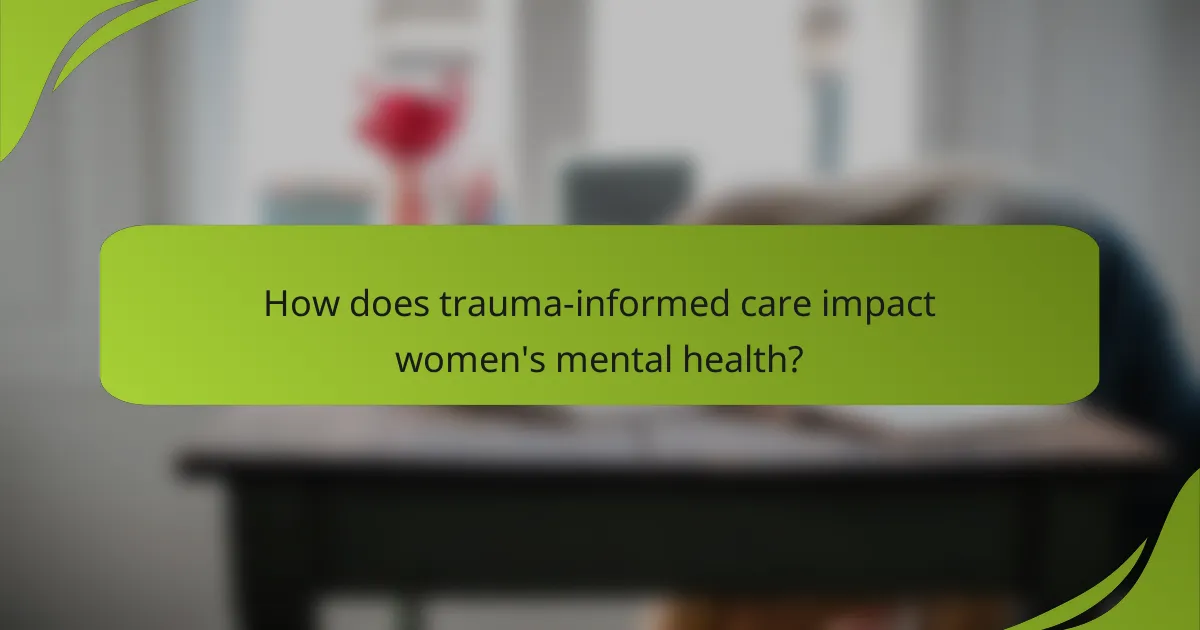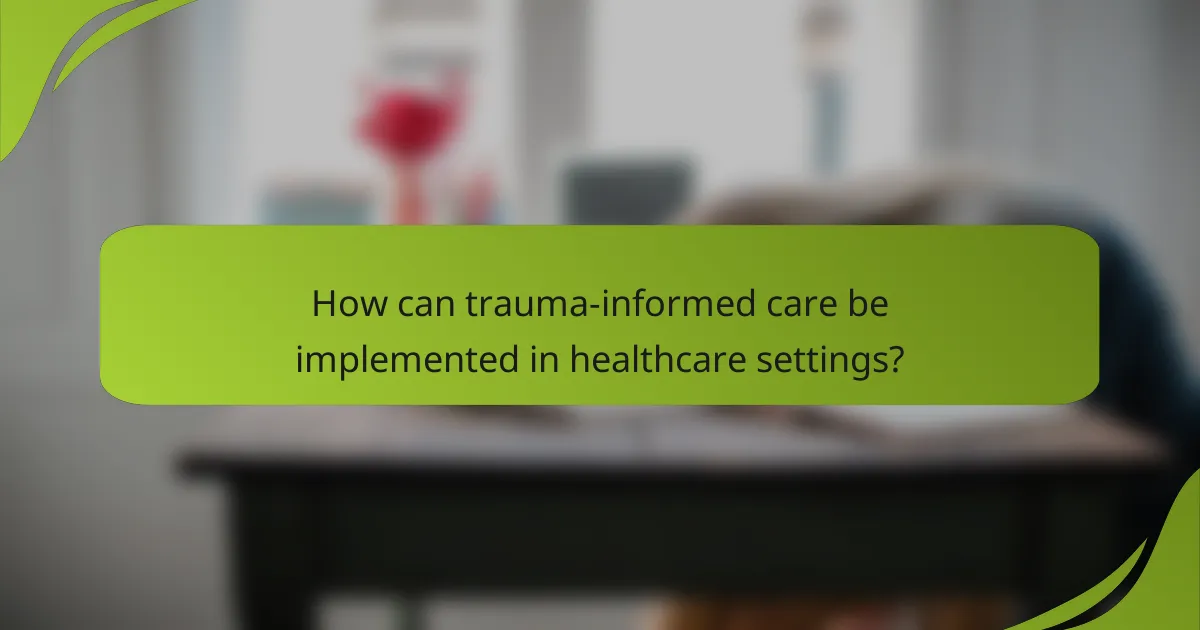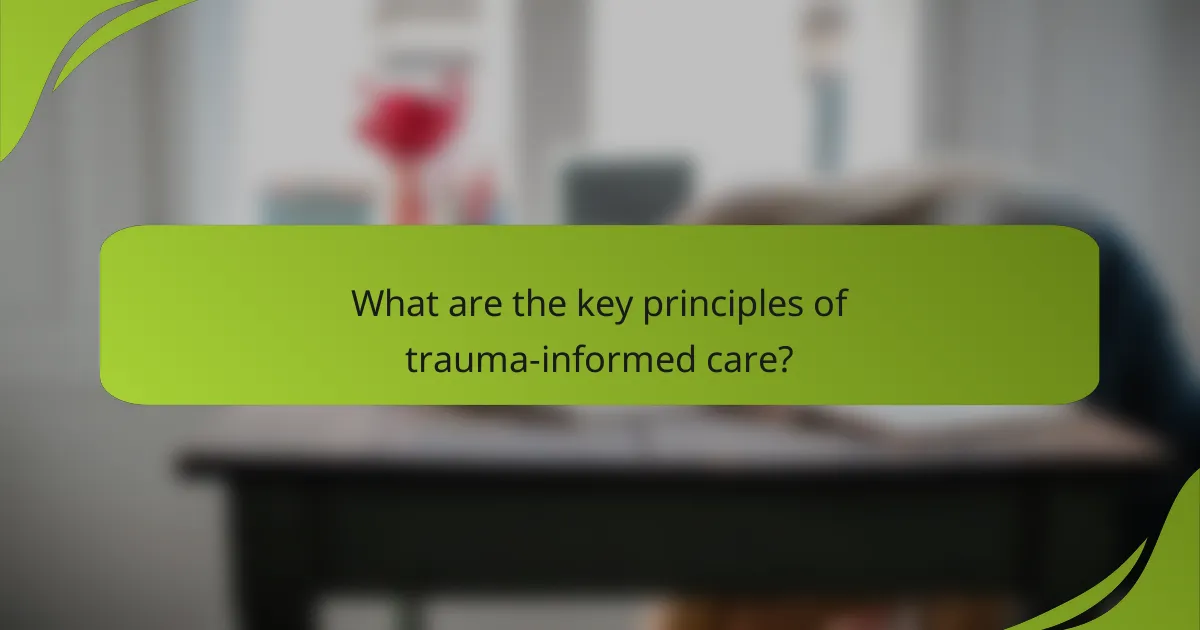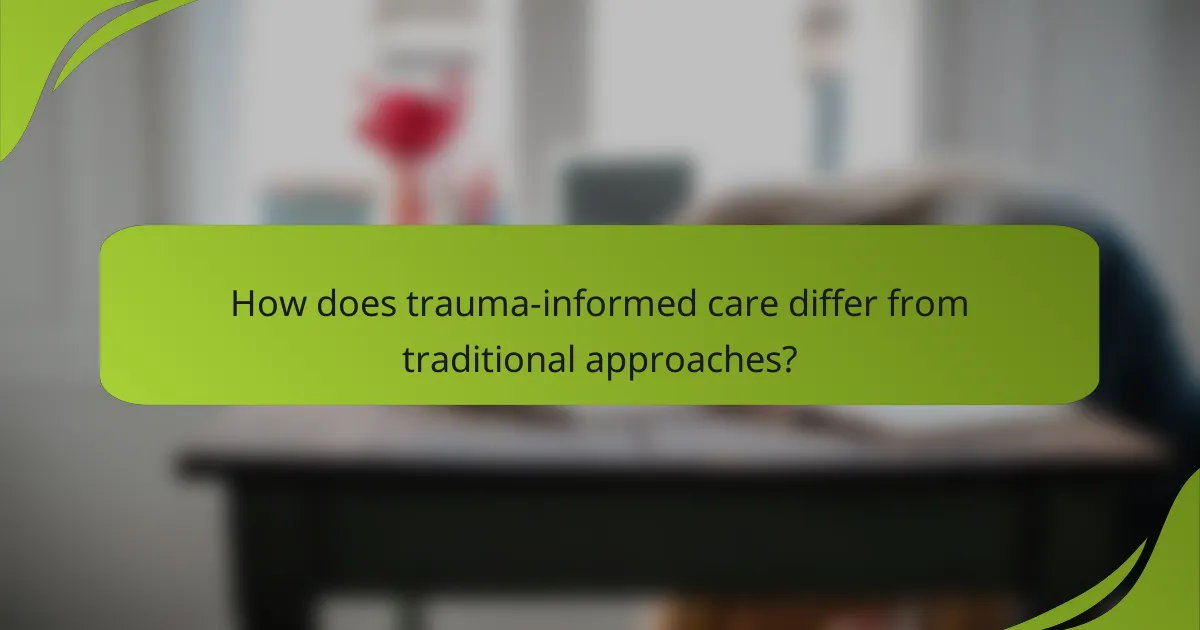Trauma-informed care plays a crucial role in enhancing women’s mental health by acknowledging the widespread effects of trauma on emotional and psychological well-being. By creating a supportive and safe environment, this approach empowers women, promotes healing, and leads to more effective mental health outcomes.

How does trauma-informed care impact women’s mental health?
Trauma-informed care significantly enhances women’s mental health by recognizing the prevalence of trauma and its effects on emotional and psychological well-being. This approach fosters a supportive environment that promotes healing and resilience, leading to improved mental health outcomes.
Improved emotional regulation
Trauma-informed care helps women develop better emotional regulation skills by providing tools to manage intense feelings. Techniques such as mindfulness, grounding exercises, and cognitive restructuring can empower individuals to respond to stressors more effectively. For example, women may learn to identify triggers and implement coping strategies, leading to a more balanced emotional state.
Additionally, creating a safe space where women feel heard and validated can enhance their ability to process emotions. This supportive atmosphere encourages open communication, which is vital for developing healthy emotional responses.
Enhanced therapeutic relationships
In trauma-informed care, the emphasis on trust and safety fosters stronger therapeutic relationships between women and their providers. When practitioners demonstrate empathy and understanding, clients are more likely to engage in the therapeutic process. This connection can lead to increased motivation and commitment to treatment, ultimately improving mental health outcomes.
Moreover, a collaborative approach in therapy allows women to feel empowered in their healing journey. By involving clients in decision-making and goal-setting, therapists can build a sense of ownership over their recovery, enhancing the overall therapeutic alliance.
Reduction in symptoms of PTSD
Implementing trauma-informed care can lead to a significant reduction in symptoms of PTSD among women. By addressing the root causes of trauma and providing appropriate interventions, such as exposure therapy or EMDR (Eye Movement Desensitization and Reprocessing), women can experience relief from distressing symptoms. These methods help individuals process traumatic memories in a safe and controlled manner.
Furthermore, integrating support systems, such as peer support groups, can enhance recovery by allowing women to share experiences and coping strategies. This communal aspect of healing can be particularly beneficial in reducing feelings of isolation often associated with PTSD.

What are the benefits of trauma-informed care for women?
Trauma-informed care offers significant benefits for women by recognizing the impact of trauma on mental health and promoting healing through supportive practices. This approach fosters a safe environment that empowers women, enhances access to mental health services, and adopts a holistic treatment strategy.
Empowerment and autonomy
Empowerment and autonomy are central to trauma-informed care, allowing women to regain control over their lives. By involving them in decision-making processes regarding their treatment, women can express their needs and preferences, which can lead to better outcomes.
Practitioners should encourage women to set personal goals and make choices about their care. This can include selecting therapy types or determining the pace of their healing journey, which reinforces their sense of agency and self-efficacy.
Increased access to mental health services
Trauma-informed care increases access to mental health services by reducing barriers that women may face, such as stigma or fear of judgment. By creating a welcoming and understanding environment, healthcare providers can attract more women seeking help.
Programs designed with trauma-informed principles often offer flexible scheduling, remote consultations, and community outreach, making it easier for women to access necessary resources. This accessibility is crucial for those who may have previously felt marginalized or unsupported in traditional healthcare settings.
Holistic approach to treatment
A holistic approach to treatment in trauma-informed care addresses not only the psychological aspects of trauma but also the physical, emotional, and social dimensions. This comprehensive perspective ensures that women receive well-rounded support tailored to their unique experiences.
Practitioners may integrate various therapeutic modalities, such as cognitive-behavioral therapy, mindfulness practices, and support groups, to address the multifaceted nature of trauma. This approach encourages women to explore different healing methods and find what resonates best with them, enhancing their overall well-being.

How can trauma-informed care be implemented in healthcare settings?
Trauma-informed care can be implemented in healthcare settings by adopting practices that recognize the impact of trauma on patients and integrating supportive strategies into the care process. This approach emphasizes safety, empowerment, and collaboration, ensuring that patients feel respected and understood throughout their healthcare experience.
Training for healthcare providers
Training healthcare providers is essential for implementing trauma-informed care effectively. This training should focus on understanding trauma’s effects, recognizing signs of trauma in patients, and learning communication techniques that foster trust and safety. Regular workshops and continuing education programs can help maintain awareness and skills among staff.
Providers should also be trained in cultural competence to address the diverse backgrounds and experiences of patients, which can influence their trauma responses. This ensures that care is tailored to individual needs and promotes a more inclusive environment.
Creating a safe environment
Creating a safe environment involves both physical and emotional aspects of healthcare settings. Facilities should be designed to minimize stressors, such as noise and overcrowding, while ensuring privacy and comfort. Simple changes like soft lighting, comfortable seating, and clear signage can significantly enhance a patient’s sense of safety.
Emotional safety is equally important. Staff should practice active listening and validate patients’ feelings, allowing them to express their concerns without fear of judgment. Establishing clear boundaries and consistent procedures can also help patients feel more secure during their visits.
Integrating patient feedback
Integrating patient feedback is a crucial component of trauma-informed care. Healthcare providers should actively seek input from patients about their experiences and preferences, using surveys or informal discussions to gather insights. This feedback can guide improvements in care practices and facility environments.
Moreover, creating a feedback loop where patients see changes based on their input fosters a sense of ownership and empowerment. Regularly reviewing and acting on patient suggestions can enhance trust and improve overall satisfaction with the care provided.

What are the key principles of trauma-informed care?
Trauma-informed care is an approach that recognizes the widespread impact of trauma and emphasizes creating a supportive environment for healing. Its key principles include safety, trustworthiness, peer support, collaboration, empowerment, and choice, all aimed at fostering resilience and recovery.
Safety and trustworthiness
Safety and trustworthiness are foundational principles in trauma-informed care. They involve creating an environment where individuals feel physically and emotionally secure. This can be achieved through clear communication, consistent practices, and establishing boundaries that respect personal space and privacy.
To enhance safety, organizations should conduct regular assessments of their environments and policies. Training staff to recognize and respond to trauma-related behaviors can also build trust, ensuring that clients feel understood and supported.
Peer support and collaboration
Peer support and collaboration emphasize the importance of shared experiences in the healing process. Individuals who have faced similar challenges can provide invaluable insights and encouragement, fostering a sense of community. This collaborative approach helps to reduce feelings of isolation and promotes mutual understanding.
Implementing peer support programs can enhance the effectiveness of trauma-informed care. These programs should be designed to facilitate open dialogue and encourage participants to share their journeys, which can empower others in their recovery process.
Empowerment and choice
Empowerment and choice are crucial in trauma-informed care, allowing individuals to take an active role in their healing journey. Providing options in treatment plans and respecting personal preferences can significantly enhance a person’s sense of control and autonomy.
Practitioners should encourage clients to set their own goals and make decisions about their care. This not only fosters self-efficacy but also helps individuals to feel valued and respected, which is essential for effective recovery. Regularly revisiting these choices can ensure that care remains aligned with the individual’s evolving needs and preferences.

How does trauma-informed care differ from traditional approaches?
Trauma-informed care focuses on recognizing and responding to the effects of trauma, contrasting with traditional approaches that may overlook these factors. This model prioritizes understanding the impact of trauma on an individual’s mental health and emphasizes creating a safe environment for healing.
Focus on understanding trauma
Understanding trauma is central to trauma-informed care. Practitioners are trained to recognize signs of trauma and its effects on behavior and mental health. This awareness helps in tailoring interventions that are sensitive to the needs of individuals who have experienced trauma.
For example, a therapist may adjust their approach based on a patient’s history of trauma, avoiding techniques that could trigger distress. This focus ensures that care is not only effective but also compassionate and respectful.
Emphasis on patient strengths
Trauma-informed care emphasizes the strengths and resilience of patients rather than solely focusing on their symptoms. This approach encourages individuals to identify their coping mechanisms and resources, fostering a sense of empowerment. By highlighting strengths, practitioners can help patients build confidence in their ability to heal.
For instance, a clinician might work with a patient to develop a personalized plan that leverages their existing support systems, such as family or community resources. This collaborative approach enhances the therapeutic relationship and promotes recovery.
Collaborative care models
Collaborative care models are integral to trauma-informed care, involving multiple professionals working together to support the patient. This team-based approach ensures comprehensive care that addresses both mental and physical health needs. Collaboration can include therapists, social workers, and medical providers, all contributing to a unified treatment plan.
In practice, this might involve regular meetings among care team members to discuss patient progress and adjust treatment strategies accordingly. Such collaboration helps create a more holistic understanding of the patient’s needs and fosters a supportive environment for recovery.

What role do community resources play in trauma-informed care?
Community resources are essential in trauma-informed care as they provide support, information, and services that help individuals navigate their healing journey. These resources can enhance mental health outcomes by fostering a supportive environment and addressing various needs related to trauma recovery.
Support groups for women
Support groups for women create safe spaces where individuals can share experiences and coping strategies related to trauma. These groups often focus on specific issues, such as domestic violence or sexual assault, allowing participants to connect with others who understand their struggles.
Joining a support group can help women feel less isolated and more empowered. Many organizations offer these groups at little to no cost, making them accessible to a wide range of individuals.
Access to legal aid services
Access to legal aid services is crucial for women who have experienced trauma, particularly in cases involving domestic violence or sexual assault. Legal aid can assist with obtaining protective orders, navigating custody disputes, or addressing issues related to housing and employment.
Many communities provide free or low-cost legal services tailored to the needs of trauma survivors. Women should seek out local organizations that specialize in legal support to ensure they receive appropriate guidance.
Partnerships with local organizations
Partnerships with local organizations enhance the effectiveness of trauma-informed care by pooling resources and expertise. Collaborations between mental health providers, shelters, and community centers can create comprehensive support networks for women.
These partnerships often lead to coordinated services, such as combined therapy and legal assistance, which can significantly improve outcomes for trauma survivors. Women should look for programs that emphasize collaboration to maximize their support options.


